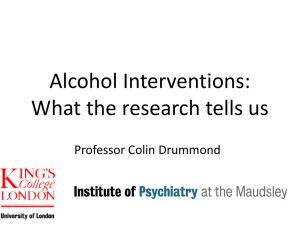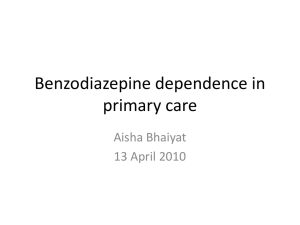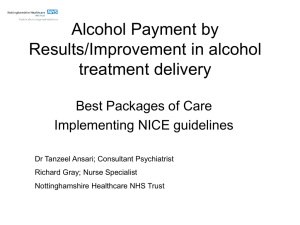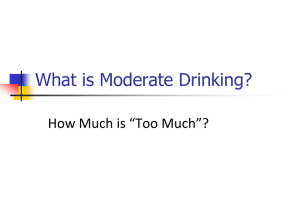CG115 Alcohol-use disorders: Slide set
advertisement
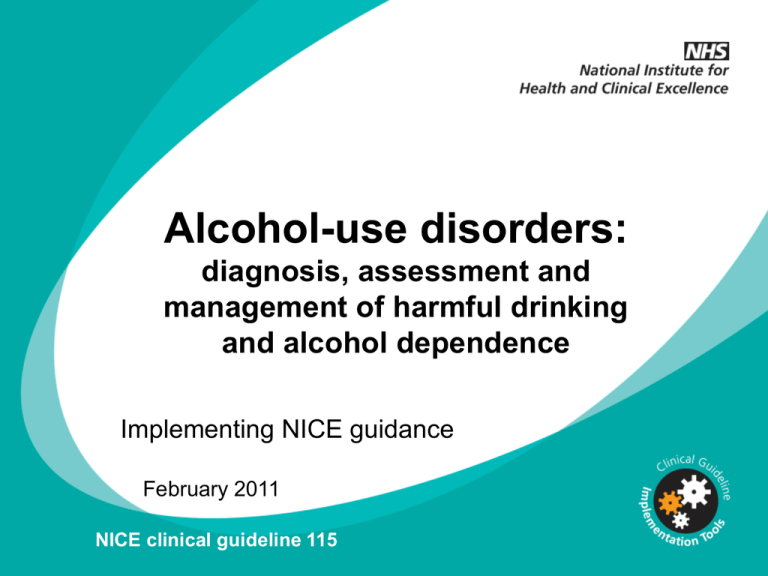
Alcohol-use disorders: diagnosis, assessment and management of harmful drinking and alcohol dependence Implementing NICE guidance February 2011 NICE clinical guideline 115 Directly related NICE guidance This guideline is one of three pieces of NICE guidance addressing alcohol-use disorders. The others are: • Preventing hazardous and harmful drinking (PH24) • Diagnosis and clinical management of physical complications (CG 100) The term alcohol-use disorders encompasses physical, mental and behavioural conditions associated with alcohol use. What this presentation covers Definitions Epidemiology Background Scope Key priorities for implementation Principles of care Costs and savings Discussion Find out more Definitions • Harmful drinking is a pattern of alcohol consumption causing mental and physical health problems directly related to alcohol • Alcohol dependence is characterised by continued drinking despite harmful consequences • Mild dependence = Severity of Alcohol Dependence Questionnaire (SADQ) score 15 or less • Moderate dependence = SADQ score of 15–30 • Severe dependence = SADQ score of 31 or more. Epidemiology Weekly alcohol consumption of more than 50 units (men) or more than 35 units (women) by age (years) and gender – Great Britain, 2009 Y = Percentage of population X = Age in years Source: General Lifestyle Survey, Office for National Statistics Background • Current practice and service provision across the country is varied • Only 6% per year of people aged 16–65 years who are alcohol dependent receive treatment • Comorbid mental and physical disorders are common. Scope • Diagnosis, assessment and management of harmful drinking and alcohol dependence in young people and adults • Does not cover children younger than 10 years or pregnant women. Key priorities for implementation • • • • • • • • Identification and assessment in all settings Assessment in specialist alcohol services General principles for all interventions Interventions for harmful drinking and mild alcohol dependence Assessment for assisted alcohol withdrawal Interventions for moderate and severe alcohol dependence Assessment and interventions for children and young people who misuse alcohol Interventions for conditions comorbid with alcohol misuse. General principles for identification and assessment Staff working in services caring for people who potentially misuse alcohol should be competent: • to identify harmful drinking and alcohol dependence • to initially assess the need for an intervention If they are not competent they should refer people who misuse alcohol to a service that can assess need. Assessment in specialist alcohol services Consider a comprehensive assessment for all adults referred to specialist alcohol services who score more than 15 on the AUDIT. A comprehensive assessment should: • • • • assess multiple areas of need be structured in a clinical review use validated clinical tools cover alcohol use, other drug misuse, physical health problems, psychological and social problems, cognitive function and readiness and belief in ability to change. General principles for all interventions: 1 Consider offering interventions to promote abstinence and prevent relapse as part of an intensive structured community-based intervention for people with moderate and severe alcohol dependence who have: • very limited social support (for example, they are living alone or have very little contact with family or friends) or • complex physical or psychiatric comorbidities or • not responded to initial community-based interventions. General principles for all interventions: 2 • All interventions for people who misuse alcohol should be delivered by appropriately trained and competent staff • Pharmacological interventions should be administered by specialist and competent staff • Psychological interventions should be based on a relevant evidence-based treatment manual • Staff should consider using competence frameworks developed from the relevant treatment manuals. Interventions for harmful drinking and mild alcohol dependence Offer a psychological intervention focused specifically on: • alcohol-related cognitions • behaviour • problems • social networks. Assessment for assisted alcohol withdrawal For service users who typically drink over 15 units of alcohol per day and/or who score 20 or more on the AUDIT, consider offering: • an assessment for and delivery of a community-based assisted withdrawal, or • assessment and management in specialist alcohol services if there are safety concerns about a community-based assisted withdrawal. Assisted alcohol withdrawal Person who drinks > 15 units alcohol per day or scores > 20 on AUDIT Assessment Consider offering: – assessment for and delivery of a community-based assisted withdrawal, or – assessment and management in specialist alcohol services if there are safety concerns about a community-based assisted withdrawal. Community-based assisted withdrawal Inpatient and residential withdrawal Intensive community programmes after assisted withdrawal for severe dependence or mild to moderate dependence with complex needs Drug regimens for assisted withdrawal • When conducting community-based assisted withdrawal programmes, use fixed-dose medication regimens and monitor the service user every other day • Fixed-dose or symptom-triggered medication regimens can be used in assisted withdrawal programmes in inpatient or residential settings • Prescribe and administer medication for assisted withdrawal within a standard clinical protocol. Interventions for moderate and severe alcohol dependence After a successful withdrawal for people with moderate and severe alcohol dependence, consider offering: • acamprosate • or oral naltrexone in combination with an individual psychological intervention. Assessment and interventions for children and young people who misuse alcohol For children and young people aged 10–17 years who misuse alcohol offer: • individual cognitive behavioural therapy for those with limited comorbidities and good social support • multicomponent programmes for those with significant comorbidities and/or limited social support. Interventions for conditions comorbid with alcohol misuse • For people who misuse alcohol and have comorbid depression or anxiety disorders, treat the alcohol misuse first • If depression or anxiety continues after 3 to 4 weeks of abstinence from alcohol, assess the depression or anxiety and consider referral and treatment. Principles of care • Build a trusting relationship • Provide information appropriate to the person’s understanding • Work with and support families and carers. Costs and savings per 100,000 population Recommendation Costs (£ per year) Offering psychological interventions to harmful drinkers and people with mild alcohol dependence 1,800 For people with mild to moderate dependence and complex needs, or severe dependence, offering an intensive community programme following assisted withdrawal –23,400 Offering acamprosate or oral naltrexone in combination with an individual psychological intervention after a successful withdrawal for people with moderate and severe alcohol dependence Estimated net saving of implementation 3000 –18,600 Discussion • How can we ensure that health and social care professionals in our organisation are competent to identify harmful drinking and alcohol dependence? • What training do staff need to enable them to assess the need for interventions in people who are drinking harmfully or who are alcohol dependent? • Which formal assessment tools do we use to assess the nature and severity of the alcohol misuse and are these included in the guidance? If not, how can we change to a recommended tool? Find out more Visit www.nice.org.uk/guidance/CG115 for: • • • • • • • the guideline the quick reference guide ‘Understanding NICE guidance’ costing report and template audit support baseline assessment tool sample chlordiazepoxide dosing regimens What do you think? Did the implementation tool you accessed today meet your requirements, and will it help you to put the NICE guidance into practice? We value your opinion and are looking for ways to improve our tools. Please complete a short evaluation form by clicking here. If you are experiencing problems accessing or using this tool, please email implementation@nice.org.uk To open the links in this slide set right click over the link and choose ‘open link’ End of slide show The following slides contain the boxes referred to in the algorithm If you used the hyperlinks in the algorithm you would have viewed the slides beyond this point The notes section of these box slides contain the recommendations in full where appropriate Inpatient and residential withdrawal Consider inpatient or residential assisted withdrawal if a service user meets one or more of the following criteria. They: • drink over 30 units of alcohol per day • have a score of more than 30 on the SADQ • have a history of epilepsy or experience of withdrawal-related seizures or •delirium tremens during previous assisted withdrawal programmes • need concurrent withdrawal from alcohol and benzodiazepines • regularly drink between 15 and 20 units of alcohol per day and have: o significant psychiatric or physical comorbidities (for example, chronic severe depression, psychosis, malnutrition, congestive cardiac failure, unstable angina, chronic liver disease) or o a significant learning disability or cognitive impairment. Consider a lower threshold for inpatient or residential assisted withdrawal in vulnerable groups for example homeless and older people. See page 20 of the quick reference guide for special considerations for children and young people. Click here to return to main assisted alcohol withdrawal pathway Intensive community programmes after assisted withdrawal for severe dependence or mild to moderate dependence with complex needs Offer an intensive community programme in which the service user may attend a day programme lasting between 4 and 7 days per week over a 3-week period. Intensive community programmes should consist of a drug regimen (see page 16 of the quick reference guide) supported by psychological interventions including individual treatments (see page 17 of the quick reference guide), group treatments, psychoeducational interventions, help to attend self-help groups, family and carer support and involvement, and case management (see page 13 of the quick reference guide). Click here to return to main assisted alcohol withdrawal pathway Community-based assisted withdrawal Service users who need assisted withdrawal should usually be offered a community-based programme – vary in intensity according to the severity of the dependence, available social support and comorbidities. Offer an outpatient based programme for people with mild to moderate dependence in which contact between staff and the service user averages 2–4 meetings per week over the first week. Outpatient-based community assisted withdrawal programmes should consist of a drug regimen (see page 16 of the quick reference guide) and psychosocial support including motivational interviewing. Click here to return to main assisted alcohol withdrawal pathway
